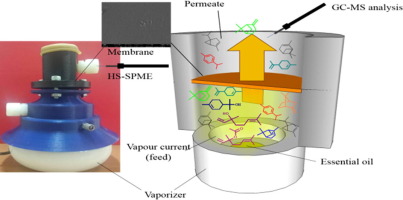Separation and Purification Technology ( IF 8.6 ) Pub Date : 2018-05-30 , DOI: 10.1016/j.seppur.2018.05.065 A. Figoli , T. Marino , F. Galiano , E. Blasi , E.L. Belsito , A. Liguori , A. Leggio , L. Rombolà , L.A. Morrone

|
Aromatherapy is a form of complementary and alternative therapy that uses essential oils extracted from different organs of aromatic plants. BEO, extracted from Citrus bergamia Risso et Poiteau (Rutaceae family, genus Citrus) fruit, represents one of the most used aromatherapy oil in the industrialized countries.
Biological effects of BEO are due to a synergistic action of the components present in the phytocomplex but it is not yet known which components are crucial for the biological activity. In this work three polymeric lab-made and two commercials dense membranes were tested for concentrating and isolating BEO volatile compounds. Lab-made membranes, composed of poly PVDF-HFP, PSU and SBS, were prepared via EIPS. Commercial investigated membranes were made of cellulose and polyamide. The membranes have been also characterized to determine morphological and surface properties. Volatile aroma compounds were isolated from BEO by means of a vapor permeation system. For this purpose, a membrane prototype which allowed to vaporize BEO and to separate specific components by their passage through the membrane, was developed. HS-SPME coupled with GC/MS was employed for the analysis of BEO volatile components both in feed and permeate. Hand-made PSU and commercial cellulose membranes were able to reject a greater number of volatile components than the other tested membranes. In particular, all cyclic and acyclic oxygenated monoterpenes (linalool, linalyl acetate, terpinen-4-ol, α-terpineol) were not detected in the permeate. The results showed that with the dense PSU membrane limonene (53.121%) and p-cymene (2.070%) contents were lower than the relative contents registered with the commercial cellulose membrane (63.440% and 3.325%, respectively), indicating a higher membrane selectivity of M3 towards these components. Contrarily, the rejection of both α- and β-pinene was higher when cellulose membrane was used (6.401% and 22.740%, respectively) in comparison to that observed for the PSU lab-made membrane (9.801% and 29.535%), respectively.
中文翻译:

聚合膜在芳香疗法中的潜力:在佛手柑精油中的应用
香薰疗法是补充和替代疗法的一种形式,它使用的是从芳香植物不同器官中提取的精油。BEO提取自柑桔柑橘Risso et Poiteau(芸香科,柑桔属)果实,是工业化国家中最常用的香薰油之一。
BEO的生物效应是由于植物复合物中存在的组分的协同作用所致,但尚不清楚哪些组分对生物活性至关重要。在这项工作中,测试了三种聚合物实验室制造的致密膜和两种商品化的致密膜,用于浓缩和分离BEO挥发性化合物。通过EIPS制备了由聚PVDF-HFP,PSU和SBS组成的实验室制膜。商业研究的膜由纤维素和聚酰胺制成。还已经表征了膜以确定形态和表面性质。借助于蒸气渗透系统从BEO中分离出挥发性香气化合物。为此目的,开发了一种膜原型,该膜原型能够使BEO汽化并通过它们穿过膜来分离特定的组分。HS-SPME与GC / MS联用用于分析进料和渗透液中的BEO挥发性成分。手工制作的PSU和商用纤维素膜比其他经过测试的膜能够吸收更多的挥发性组分。尤其是,在渗透液中未检测到所有环状和非环状的氧化单萜(芳樟醇,乙酸芳樟酯,萜品四醇,α-萜品醇)。结果表明,采用致密的PSU膜柠檬烯(53.121%)和对-丁烯(2.070%)含量低于商业纤维素膜的相对含量(分别为63.440%和3.325%),表明M3对这些组分的膜选择性更高。相反,与使用PSU实验室制膜(分别为9.801%和29.535%)观察到的情况相比,使用纤维素膜时(分别为6.401%和22.740%)对α-和β-pine烯的截留率更高。



























 京公网安备 11010802027423号
京公网安备 11010802027423号